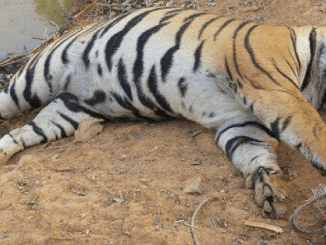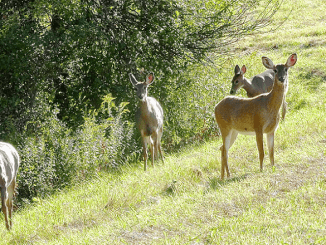
COPENHAGEN, Denmark, December 10, 2021 (ENS) – More tigers now live in illegal captivity on so-called tiger farms than in the wild, raised from cubs as livestock, and slaughtered when mature to harvest their skeletons and body parts for the manufacture of tiger bone glue.
This brown, sap-like substance is produced by dissolving tiger skeletons in a high-pressure cooker for two to three days, says Dang Vu Hoai Nam, a PhD Fellow at the University of Copenhagen’s Department of Food and Resource Economics, coauthor of the first study focusing on the buyers of tiger bone glue.
“Tiger glue’s extreme popularity,” he explains, “is a major reason why these animals end up being boiled down in Vietnamese basements, like those of Nghe An,” a province in north-central Vietnam bordering Laos and the Gulf of Tonkin, where facilities are operated by numerous smaller producers.
With fewer than 3,900 left in the wild, tigers are classed as an Endangered species. The sale of tiger parts and products is prohibited by Thai and Vietnamese law, while international trade is prohibited by the Convention on International Trade in Endangered Species, CITES.
Producers of tiger bone glue buy tigers from farms as cubs and raise them for use of their skeletons and body parts to produce illegal traditional medicine. Buyers believe this substance can treat rheumatic diseases and other ailments.
Due to the illegal nature of this trade, the details of who buyers are, their preferences and what motivates them to pay upwards of US$15,000 per kilo (2.2 pounds) for tiger bone glue had never before been studied.
After a considerable amount of time networking, Dang Vu managed to get close to buyers, whose preferences were analyzed in the new study, published in Journal for Nature Conservation.
“Among other things, we gained access to the tennis and golf clubs where many of these buyers spend time. These people are from Vietnam’s most affluent class, typically senior citizens who earn about 15 times as much as the average Vietnamese person,” he says.
The research team found that buyers typically mix the finished “glue” into wine and vodka, which is then consumed daily.
Together with his team, Dang Vu tracked down and gained the confidence of 228 Vietnamese buyers and tiger bone glue users. He had a few questions for them, detailed, personal questions about their preferences and trade-offs for different attributes of their purchase choice, including legality, source, purity, and price.
Forty percent of the 228 buyers interviewed reported that they use tiger bone glue for musculoskeletal ailments. Thirty-two percent use it for their overall health, six percent use it to prevent diseases and five percent to enhance their sexual performance.
Dang Vu and his research team calculated consumers’ willingness to pay for each attribute level under the current trade ban and in a hypothetical legal trade.
Consumers preferred and were willing to pay more for wild than farmed tiger glue and a higher proportion of tiger bone in the glue. Consumers also preferred legal over illegal sufficiently for most to switch from illegal wild to legal farmed tiger.
The scientists concluded that “a legal trade will shift preferences significantly towards farmed tiger glue from legal sources but will not eradicate demand for wild tigers, likely leading to the parallel operation of legal and illegal markets.”
Poached Wild Tiger Bones in the Glue
The ingredients of tiger glue don’t just come from tiger farms, but also from poached wild tigers.
The provenance of the raw materials and manufacturing processes matter to Vietnamese buyers, explains Dang Vu. “Most of the buyers we interviewed prefer tiger bone glue from wild tigers over farmed ones because they believe wild bones are more potent, and thus provide better treatment for a host of musculoskeletal diseases. At the same time, buyers seek the highest possible tiger bone content in their mixture.”

To tackle the poaching problem, politicians and authorities in Vietnam and other parts of Asia are now considering whether to legalize the breeding and use of tigers for tiger bone glue, among other things.
But Dang Vu says his study and buyer preferences demonstrate that legalizing tiger farming is unlikely to solve the problem of poaching.
“Even with legalization, demand for wild tigers will remain strong. A third of our respondents are still willing to buy tigers poached in the wild, which will simply sustain the black market,” Dang Vu argues.
According to him, solving the problem is more about improving tiger conservation measures and equipping consumers with better information about the illegal product.
“Rather than legalization,” concludes Dang Vu, “vulnerable countries should increase their investments in natural tiger habitats, the strengthening of police and park ranger forces, and information campaigns aimed at consumers that point them towards treatment alternatives which are more sustainable than tiger bones.”
Research conducted by the international NGO Environmental Investigation Agency established in 2017 that on 200+ tiger farms in China, Lao PDR, Thailand and Vietnam, between 7,000 and 8,000 tigers are raised as livestock.
Their numbers are roughly twice the 3,900 tigers that the World Wildlife Fund estimates remain in the wild today. WWF is calling for greater oversight and protection of all captive tigers.
Featured image: Vietnamese authorities bust an illegal tiger farm in Nghe An Province. The captive tigers were tranquillized and transported in trucks to an ecological area in the province. August 4, 2021 (Photo courtesy Nghe An Police Department)



